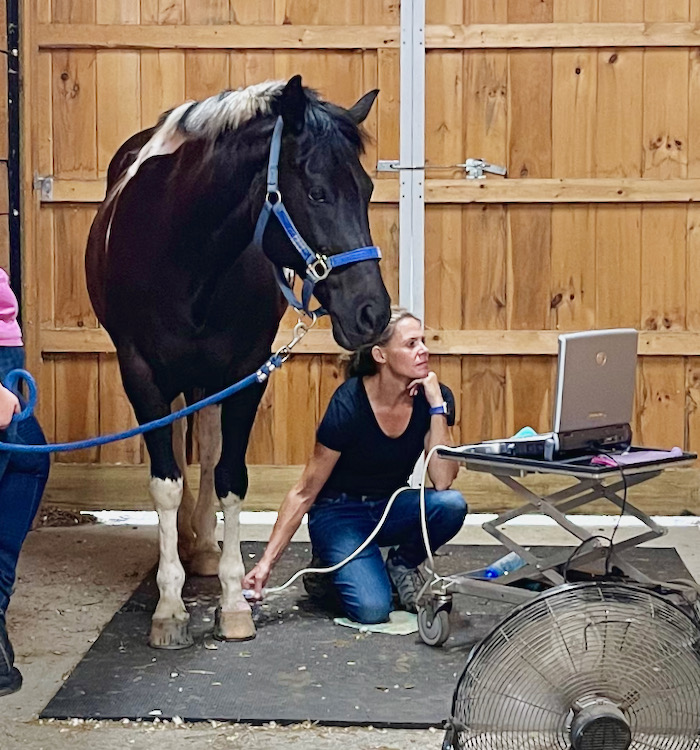Tonka and Dr. Monika Calitri discuss his ultrasound results.

For the last four years, Tonka has been consistently inconsistently lame in his left fore. Most of the time there’s nothing amiss, some of the time there’s a slight unevenness to his stride, occasionally he’s head-bobbing lame. It’s hard to diagnose because – of course – whenever the veterinarian comes out to take a look he’s sound. Or at least not lame enough to be able to do thorough diagnostics.
Dr. Monika came out again this week. Two days before the appointment Tonka was limping lame, but when Dr. Monika arrived he looked fine. So I got on and rode for a half hour until you could detect an unevenness to the left. Also, Tonka refused to canter. Two weeks ago he was doing perfect walk to canter transitions. Now he wouldn’t budge. The inability to canter might be a learned behavior that has nothing to do with the canter itself – when Tonka balks, I stop asking him to go forward – or it might be that the canter itself hurts (sacroiliac joint?) What is clear is that there’s something bad going on in Tonka’s left front, likely originating somewhere from the fetlock on down. We’ve already done X-rays that showed that the bone angles and joints look fine. To try to isolate where the pain is coming from, Dr. Monika injected nerve blocks. First to nerves that go to the inside of the hoof. Then she watched Tonka go to see if there’s a difference. He was still lame on the first block, but when she then blocked Tonka’s leg further up it improved his way of going. This is far from exact, especially with a horse whose lameness isn’t pronounced in the first place, but it can eliminate some areas of concern and point to others that are more likely. An ultrasound maybe, or maybe not, hinted at his collateral ligament (which wraps down from the fetlock and into the hoof) as being the culprit.
The next stop is for more advanced imaging. He’ll get an MRI at Tufts (a clinic at that veterinary college). Scheduling an appointment is the first challenge. It could be weeks before they can see Tonka. In the meanwhile, what do we do? He needs to be lame to get a diagnosis, so keep him in work and hope that the inconsistent lameness becomes more consistent? On the other hand, if it’s a ligament, I don’t want to stress it more so that it’s impossible to heal later.
There’s no perfect solution. I think what I’ll do is get out on Tonka for walks. It’s perfect hacking weather. He’s always remained sound at the walk. A week before the appointment I’ll put him back into full work, assuming that he’ll go lame enough again to show the Tuft’s team what hurts. That’s the plan. It’s not ideal, but after consulting with my veterinarian and trainer it’s the best that we can come up with.
Horses.
Sigh.


So sorry to hear about Tonka. Good luck on your journey to find the cause,
Thanks!
Wishing you the best outcome for Tonka. Being stuck in limbo like this is difficult for both of you. I hope the issue is a simple one to manage once you find it.
Simple would be wonderful. At least with all of the training I have in Tonk, and his innate good-nature, whatever I have to do, he’ll be a good patient.
Ugh, what a choice. Your plan sounds like the best of the alternatives, depending on when you can get an appointment at Tufts. In the meantime, enjoy autumnal hacking!
What a lovely personality Tonka has, calmly looking over Dr. Monika’s shoulder during the ultrasound.
Such a good pony. He shares those good vibes with everyone 🙂
Vets have it way harder than doctors. Their patients can’t tell them where it hurts. It’s so frustrating trying to pinpoint these things, and in the meantime you’re just in limbo. I hope you get answers soon.
I feel for you! Been there, done that; will likely go through it again. :-/